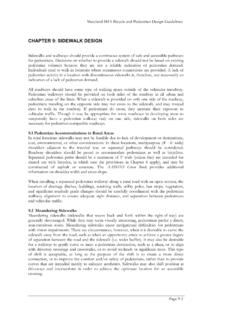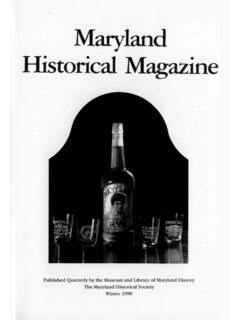Transcription of B.2 History of Suburbanization in Maryland
1 History of Suburbanization in Maryland Suburbanization throughout Maryland was largely influenced by the same trends that propelled the movement across the United States. Like most areas, suburban development in the areas around the state's urban centers was directly related to transportation routes, including railroad lines, streetcar/trolley lines, early road networks, and freeway construction. In addition, the location and layout of suburbs were influenced by such factors as the ethnic heritage and the income of prospective residents. There has been very little information written on the trends and History of Suburbanization in Maryland in general, partially due to the fact that prior to World War II, only baltimore and Washington, were involved in the Suburbanization trend to any great extent.
2 The discussion of baltimore is presented because Maryland s suburban trends began in baltimore and therefore give a more complete understanding of Suburbanization in Maryland . Montgomery and Prince George's counties are only treated in a minor way in this section, being more closely associated with the trends of Suburbanization in Washington, than in Maryland . The two counties are presented more fully in Section , History of Suburbanization in the Washington, Area. Agricultural-Industrial Transition Period (1815-1870) In Maryland , the majority of transportation routes originated from major cities, namely baltimore and later Washington, , and between ports, markets, and milling centers.
3 The four Maryland counties that tended toward Suburbanization surrounded those areas, specifically baltimore County, Anne Arundel County, Montgomery County, and Prince George's County (Callcott 1985, 20). The development of suburban baltimore was largely influenced by the trend of cities towards annexation, and the problems associated with incorporating non-urban areas into the city limits. After 1776, the city of baltimore grew well beyond the municipal boundaries, and by the early 1800s, a large urban population lived in "the precincts" adjoining the city. The "precincters" comprised almost one third of baltimore County's population, and the lands owned by the precincters accounted for over forty percent of the county's total property value (Arnold 1978, 110).
4 City officials sought to capture that wealth by annexing the territory into the city. In the city's 1816 appeal to the state government, they concentrated on the need for a coordinated city plan, and failed to mention their desire for an increased tax base. The city won its petition, and the extensive area added to the city in 1817 contained almost all urban growth within the new boundaries until after the Civil War (Arnold 1978, 111). baltimore had an early History of "suburban" development. Only a few houses had been built near the Washington Monument in baltimore in 1839 when two builders, James and Samuel Canby, proposed a large-scale development of middle-class housing on the western outskirts of town.
5 They bought a thirty-acre tract and offered a square in the middle as a public park. Franklin Square became the first of many similar squares, including Lafayette, Harlem Park, Perkins Spring, Johnson, Madison and Collington. The early suburbs were accessible through the services of an omnibus in 1844. Within the first decade, Washington Square, Fells Point, Canton, Towsontown, Ashland Square, and Franklin Square could be reached by omnibus (Green 1980, 98). B-14 In 1851, disputes over sharing the costs of several public institutions caused the city and county to separate, resulting in the relocation of the county government to Towsontown, seven miles north of baltimore .
6 Both remained wary; the county distrusted the city's landholdings outside the city boundaries that it used for its almshouses, parks, and water system. The city residents were upset at the use of city schools, fire protection, and police by non-taxpaying county residents. After 1864 and the enactment of the State Constitution, baltimore City could no longer annex a portion of the county without the consent of the residents of the area. baltimore County had inserted the clause requiring a vote for annexation to prevent its most valuable areas from being annexed by the city. Since the city still provided many services to the county without receiving tax money in return, the city government felt justified in asking for an expansion of the city boundaries.
7 The county residents opposed the higher taxes associated with living within the city boundaries, and voted down the annexation in 1874. Industrial/Urban Dominance Period (1870-1930) Access provided by horse-car lines and later electric streetcars encouraged further development outside of city lines in the 1870s and 1880s. Fashionable townhouses were built along Madison Avenue and McCulloch Street, on Eutaw Place, and in Bolton Hill. Such diverse areas as Arlington, Highlandtown, Huntingdon, Mt. Washington, Peabody Heights, and Pimlico began to grow as a result of the more rapid public transportation systems (Green 1980, 144).
8 The suburban problem rose to prominence in baltimore once again. An area called "the Belt" had developed, encircling the city on three sides with industrial and residential settlements of approximately 20,000 people by 1874. The growth occurred just over the city line, and extended along the new suburban horse-car lines up the Jones Falls Valley. baltimore once again annexed territory in 1888, assuming control of over two-thirds of the suburban area opened by the horse-car lines between 1865 and 1888 (Arnold 1978, 117). baltimore streetcar lines were electrified in the 1890s, stimulating a new suburban belt outside the municipal boundaries. Modest towns like Pikesville, and Catonsville grew along the trolley lines that extended out from baltimore .
9 By 1910 motor vehicles and improved roads opened an even larger area. County citizens developed organizations to encourage improved conditions in the area north of the city. The success of their efforts removed some of the desire of county citizens to become part of the city in order to gain city utilities, but enough county citizens still voted in favor of annexation, allowing the City of baltimore to annex more land in 1918 (Callcott 1985, 20). More than other areas in Maryland , baltimore had a large ethnic population, spurred by intense immigration from Europe as well as migration of former slaves from the south, that lived in various neighborhoods around the city.
10 The city was home to the nation's largest free African-American community during the antebellum period. African-Americans occupied enclaves on the east and west sides of the business district, with the elite living in the area north of the city, from Mt. Vernon Square to beyond Guilford and B-15 Roland Park. The Jewish population lived in an area to the northwest and moved farther and farther out as African-Americans began to occupy a larger portion of the city. An Italian enclave occupied the western area of the city, and a portion of the northeast area. There was a German population to the southwest; German, Greek, and Irish communities were located in the south; immigrants from Poland and Czechoslovakia settled in the southeast; Polish and Greek communities were settled in the east, and a mixed community of Italians and Germans was located in the northeast (Callcott 1985, 2).



















